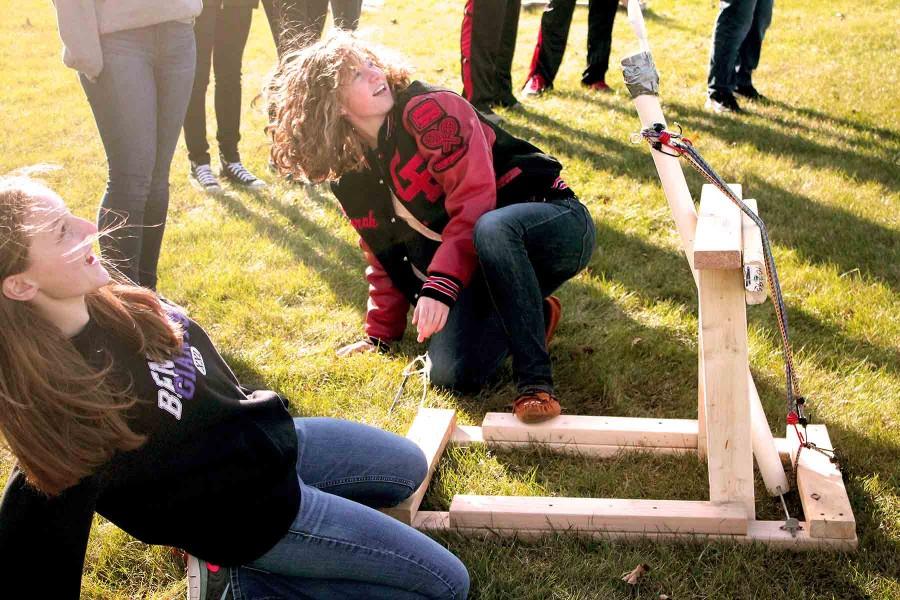The siege of Cannon Falls
CFHS Physics class stages catapult contest
Abby Van Zuilen and Sarah Modrak react to their catapult launch.
Golf balls, baseballs, softballs, and basketballs flew through the air in front of the Cannon Falls High School’s doorsteps on Tuesday, November 24th. Students in the physics class sent the various projectiles into the sky with the permission and supervision of Richard Bennett, who teaches the class. The siege weapons that allowed them to do so were the students’ very own hand built catapults. There were five unique structures built by 20 intellectual, hardworking, and determined students.
Mr. Bennett said that this is a great project for the students to do because it gives them “a hands on idea about projectile motion”. Since this project has been going on for a very long time, it has become one of his favorite sections. He also stated that “the students have more enthusiasm every year, and the catapult’s sizes increase, too.”
Building the catapults took the students about a month. They began by studying projectile motion and the sciences behind how the object would take flight. “It was difficult coming up with plans to build the catapult at first, because we didn’t know how to create enough force to send the ball”, says physics student Sarah Modrak. As the equations and labs began to make more sense, the young physicians began to think like engineers. Supplies were gathered, as well as blueprints and designs. A mental image of a grand renaissance tool was branded in their minds. Of course, safety was a major factor the students had to consider when coming up with ideas, and some blueprints had to be tossed out.
we didn’t know how to create enough force to send the ball
— Sarah Modrak
When they were finally ready to start building the catapults, the students were more than eager. “I just wanted to get it done and see what it does”, Modrak expressed. The most common materials used were wood planks, wood blocks, bungie cords, springs, and tupperware to hold the ball. It was incredible to see these students working together this hard to achieve a common goal. They made the plans, cut the wood, screwed in the nails, and adjusted things as necessary. Many of the catapults looked similar, but that doesn’t mean anyone stole anyone else’s ideas. As we looked closer, each catapult worked in a different way, but still got the same job done. Some devices employed metal poles, and some were shot by bungie cords. Others worked entirely on a combination of springs and the force they generated.

A catapult sits, ready for the launch
The requirements for the students catapults were to send a projectile at least the size of a golf ball 10 meters. All of them made it past the 10 meter mark and some went far beyond. The task was obviously a very challenging experience, and working with these materials hands on was difficult at first. In the end, it was amazing to see what these students were able to produce, and the power some of the catapults created. It was also great to see how intelligent the students are CFHS are, and the products they have, and can make.

Aleena is the Assistant Video Editor and is a senior at CFHS. She enjoys shredding on her snowboard, scoring sweet goals in soccer, and breathing.


